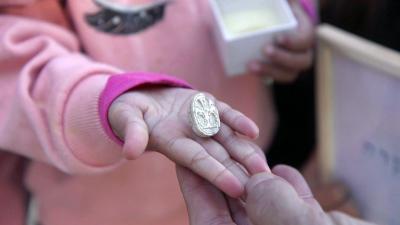Jerusalem, Israel - April 1, 2025 - While walking with her family on a trip to Tel Azeka, near Beit Shemesh, 3.5-year-old Ziv Nitzan picked up a stone that turned out to be an ancient seal amulet from the Middle Bronze Age.
Early this past March, during a family trip to Tel Azeka, near Beit Shemesh, 3.5-year-old Ziv Nitzan from Moshav Ramot Meir found an ancient scarab amulet, about 3,800 years old. “We were walking along the path, and then Ziv bent down – and out of all the stones around her, she picked up this particular stone,” recounts Omer Nitzan, Ziv's sister. “When she rubbed it and removed the sand from it, we saw something was different about it. I called my parents to come see the beautiful stone, and we realized we had discovered an archaeological find! We immediately reported this to the Israel Antiquities Authority.”
Semyon Gendler, Judah Region District Archaeologist on behalf of the Israel Antiquities Authority, praised Ziv and her family for reporting the find, and awarded her a certificate of appreciation for good citizenship. The ancient find will be included in a special display for Passover that the Israel Antiquities Authority has prepared at the Jay and Jeanie Schottenstein National Campus for the Archaeology of Israel, alongside other finds from the days of Egypt and Canaan, most of which are being displayed for the first time.
Dr. Daphna Ben-Tor, an expert in ancient amulets and seals, determined that the seal found by Ziv is a Canaanite scarab from the Middle Bronze Age – dating to about 3,800 years ago. She says, “Scarabs were used in this period as seals and as amulets. They were found in graves, in public buildings and in private homes. Sometimes they bear symbols and messages, that reflect religious beliefs or status.”
The scarab seals are tiny ornate objects, originating in ancient Egypt and designed in the shape of a dung beetle. This beetle, considered sacred in the eyes of the ancient Egyptians, was a symbol of new life, because of the dung ball it created and then laid its eggs into it, from which new life would hatch. Its name in Egyptian derives from the verb “to come into being”, or “to be created”. This is because the Egyptians saw the scarab as a symbol of the incarnation of God the Creator.
The scarab Ziv found was discovered at the foot of Tel Azeka – an important archaeological tel near Beit Shemesh. In this mound, evidence was discovered of many changing cultures over the course of history. Amongst other things, excavations by Tel Aviv University have revealed findings from the days of the Judahite Kingdom, including city walls, agricultural installations, and more. Tel Azekah was also known as a key feature in the biblical battle scene between David and Goliath as described in the Book of Samuel (Samuel I 17:1).
“We have been excavating here for almost 15 years, and the excavation findings show that during the Middle Bronze and Late Bronze Ages, here in Tel Azekah, thrived one of the most important cities in the Judean Lowlands,” says Prof. Oded Lipschits, director of the Tel Aviv University archaeological dig, who even came to meet Ziv and her sisters at the tel. “The scarab found by Ziv joins a long list of Egyptian and Canaanite finds discovered here, which attest to the close ties and cultural influences between Canaan and Egypt during that period.”
According to Israeli Minister of Heritage, Amichai Eliyahu, “The seal that little Ziv found during a family trip to Tel Azekah connects us to a grand story, that of the ancient civilizations that lived in this land thousands of years ago. The scarab Ziv found also reminds us that in the Land of Israel, even children can be a part of discovering history.”
“Ziv, and her family, deserve praise for handing over the find to the National Treasures of the state of Israel,” says Eli Escusido, Director of the Israel Antiquities Authority. “Thanks to her, everyone will be able to see it and enjoy it. In honor of Passover, we will present the seal in a special exhibition set up by the Israel Antiquities Authority at the Jay and Jeanie Schottenstein National Campus for the Archaeology of Israel, alongside other findings from the Egyptian and Canaanite eras. In our public tours we will present impressive items for the first time, including seals of the pharaohs, Egyptian statues, ritual vessels, and evidence of the Egyptian cultural influence in the Land of Israel – and everyone is invited!”




























